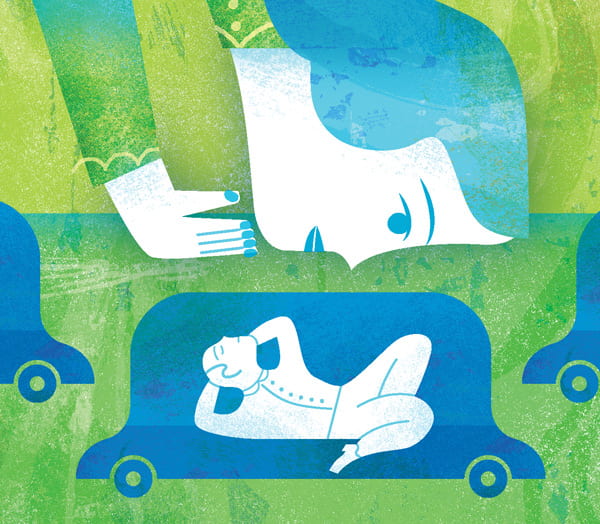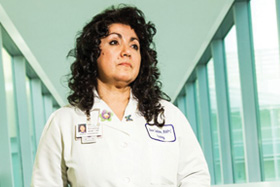From Zero to Safety
Autonomous vehicles are the future. Are they safe? Assistant Professor of Aviation Francesca Favaro and her research team are assessing the risks and rewards of the next generation of transportation.
“A big shift in thinking we can’t really conceive of right now will be required.” — Francesca Favaro, assistant professor of aviation
There was an explosion in space. Red buttons flashed. Alarms buzzed. And then came the astronaut’s call: “Houston, we have a problem.” When Francesca Favaro watched this scene from Apollo 13 as a child in Italy, she knew she wanted to be the person answering that call.
“I like solving problems and calling the shots based on data,” says the SJSU assistant professor of aviation and expert in autonomous systems. A pilot and Federal Aviation Administration-certified advanced ground instructor, Favaro began studying systems safety and human-machine interactions in aviation as an aerospace engineering doctoral student at Georgia Tech. However, after her brother narrowly survived a car accident, Favaro broadened her focus to road safety.
“Ninety-four percent of automobile accidents are caused by human distraction and human error,” says Favaro. “I want to see if self-driving vehicles are a better option for the future. The key problem when you do risk assessment for new technologies is that you are starting from zero. There are no rules, no certifications in place.”
Favaro set out to influence policies and regulations as they are being developed by establishing her Risk Assessment in Autonomous Systems (RiSA2S) lab in fall 2016, her first semester at San Jose State. Leveraging perspectives from multiple disciplines, Favaro’s RiSA2S team includes two graduate and seven undergraduate students from three SJSU colleges: engineering, science and social sciences. They are conducting research to move autonomous vehicle technology forward—and ensure that it is integrated safely.
A Data-Driven Path
Autonomous vehicle technology is already on its way. With the goal of bringing vehicles to market in the next five to 10 years, many manufacturers are testing vehicles on the road, attempting to address the technology question: How do you get a vehicle that navigates roadways using a complex set of sensors to process enormous amounts of data in real time? The RiSA2S team is studying accidents on the road to finding technology solutions.
Favaro was among the first researchers to analyze the California Department of Motor Vehicles’ public data on accidents that involve autonomous vehicles—and has offered recommendations for integrating best practices from aviation accident reporting.
“Research is fun, but research with people is even more fun because people are strange and weird and interesting.” — Sky Eurich, ’17 Aviation, ’19 MS Human Factors
“Once I looked at what the manufacturers were doing, I figured out there was a problem with how human drivers react to disengagements,” says Favaro. Current vehicles are considered semi-autonomous, requiring the presence of a human driver who can constantly monitor the vehicle’s operation and outside environment, and immediately take control of the vehicle if the autonomous technology fails. “When the technology fails and the human driver has to take control of the car, we call that a disengagement.”
With momentum from her initial data analysis, Favaro was able to attract funding to take a closer look at disengagements. She also partnered with the Lucas College and Graduate School of Business’ Mineta Transportation Institute (MTI), whose goal is to increase mobility for all by improving the safety, efficiency, accessibility and convenience of the nation’s transportation system. Supported by the U.S. Department of Transportation, MTI does regular outreach with the federal government, Caltrans, local transit agencies, elected officials within the region, the MTI board of trustees, and other stakeholders to identify critical transportation issues that need to be investigated.
“Transportation is the linchpin of our economy and our society. It’s all about the mobility of people and goods,” explains Karen Philbrick, MTI executive director. “The difference between having and lacking access to mobility is no less than the difference between having and lacking access to opportunity. Without mobility, people can’t live full, rich, multifaceted lives.”
Trained as a psychologist, Philbrick says recent research demonstrates the impact of social support on one’s longevity, which may be impacted by access to transportation. Autonomous vehicles could enhance social support for those with mobility limitations and challenges, including the elderly. “The future is going to include fully autonomous vehicles and other technologies,” says Philbrick. “To prepare for that, we need this type of research.”
Human-Machine Collaboration
Studying human-machine interactions in autonomous systems requires a multidisciplinary approach—from human factors and computer science to software and systems engineering. Favaro’s students are fully engaged in the research process, getting hands-on experience and publishing in scholarly journals.
For the disengagement study, the RiSA2S team placed human drivers in a car simulator capable of handling both human and autonomous driving, owned by FKA Silicon Valley. In semi-autonomous vehicles, a human pilot cooperates with the software that acts as the “brain” of the vehicle, and serves as backup whenever the software autopilot disengages after a failure. The goal was to understand how quickly and efficiently drivers could take control of the vehicle. “In the safety-critical situation of a disengagement, it is important to ensure that the human driver has enough time to react and respond effectively to the vehicle’s request for human control,” says Favaro.
Engaging drivers in three age groups (18-34 years, 35-54 years and 55+ years), the team tested vehicle control takeover metrics, including response times and vehicle drift from the road’s centerline, under several different scenarios, and measured situational awareness of people in the car. Afterward, they asked the drivers questions to figure out exactly how much they were paying attention.
A member of the research team and an Army veteran, Sky Eurich, ’17 Aviation, ’19 MS Human Factors, does human factors work at Verily Life Sciences, a biotech company that used to be part of Google X. For the disengagement study, Eurich focused on subjects’ response times. In the study’s scenario, subjects monitored the vehicle as it drove itself, then the vehicle stopped driving itself, played a warning sound and flashed an image telling the driver they needed to begin driving.
“We measured how long it took people to begin driving. Basically, how long it took for drivers to complete three possible inputs: breaking, throttle and steering. That is, stepping on the brake, stepping on the gas or applying torque to the steering wheel,” says Eurich. “Research is fun, but research with people is even more fun because people are strange and weird and interesting. With people, no matter what, it’s always going to be a learning experience, because somebody will do something you didn’t anticipate.”
Nazanin Nader, ’18 MS Industrial and Systems Engineering, came to San Jose State to be in Silicon Valley, where “we get to see more and more autonomous cars on the street.” Being part of the research project allowed Nader to follow her curiosity about autonomous vehicles.
“We tried to find interesting patterns and trends from the data,” says Nader. “For example, you wouldn’t think that older people would be better at taking back control when the car disengages from fully autonomous driving, but that was the case in our study.”
Favaro says situational awareness is estimated based on recollection of specific things during the test. The team got creative to determine if drivers were paying attention. Along the highway in one scenario, the drivers passed a funny-looking building. In another scenario, drivers passed four big statues depicting a family of horses or a billboard with a pink giraffe asking, “Do you think I’m cute?” As observers, the team also took notes on what the people were doing when they were not driving.
The results of Favaro’s autonomous vehicle disengagement study could have important regulatory implications. Of the two speed settings tested in the study, a high speed of 65 mph and low speed of 55 mph, test subjects performed better at the lower speed, pointing to the importance of setting maximum speed thresholds for autonomous vehicles when a human driver serves as backup. The establishment of a speed threshold could also reduce vehicle drift and lead to better control when a driver must take control of a vehicle. Wider, dedicated lanes for semi-autonomous vehicles separated from conventional traffic may also be needed, says Favaro.
Merging Old and New
In a short time, Favaro has become one of MTI’s “star researchers,” says Philbrick. Each RiSA2S study builds on those the lab team has completed, training the next generation of transportation professionals and providing important insights about autonomous vehicle safety for policy and law makers. Down the road, Favaro says the challenge is going to be logistics.
“Let’s imagine all of a sudden everybody has a Tesla. What does that entail for other stakeholders? Suddenly, we’re no longer selling gas. What about interfacing with older types of vehicles? Do you have dedicated lanes for each type? Do you have them merge together?” says Favaro. “There are lots of questions about integration that are going to come into play. This is where there is a parallel with the aviation and aerospace industry, because air traffic control has been dealing with logistics problems for years. Do you need to have a ground control center?”
Autonomous vehicles have the potential to make roads safer, reducing the number of deaths due to accidents, but also to ease traffic congestion and improve commute and parking times, explains Favaro. Imagine a future where people no longer own vehicles and only use ride sharing in autonomous cars that operate nonstop and are never parked. What if parking lots were no longer needed? Favaro believes that could mean more green spaces, playgrounds and parks.
“A big shift in thinking we can’t really conceive of right now will be required. Not everybody will willingly give up their car. We’re used to the old ways, but maybe the next generation or the one after will have a completely different experience,” says Favaro. “For the next 10 or 15 years, regular cars are not going anywhere, so we’re going to face the problem of merging old and new. We need to have a plan for how do that safely.”






